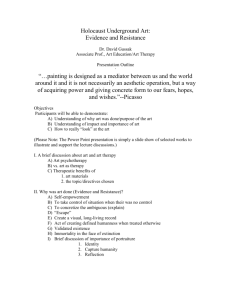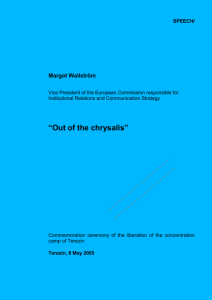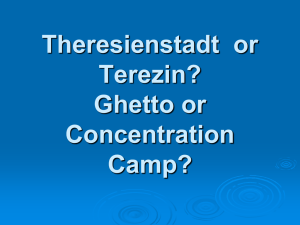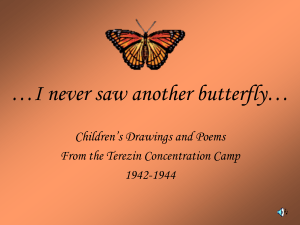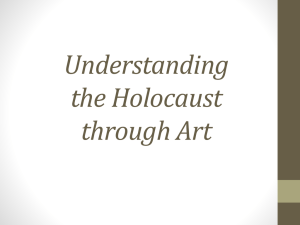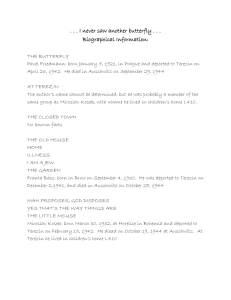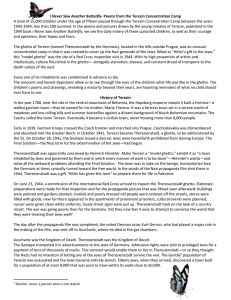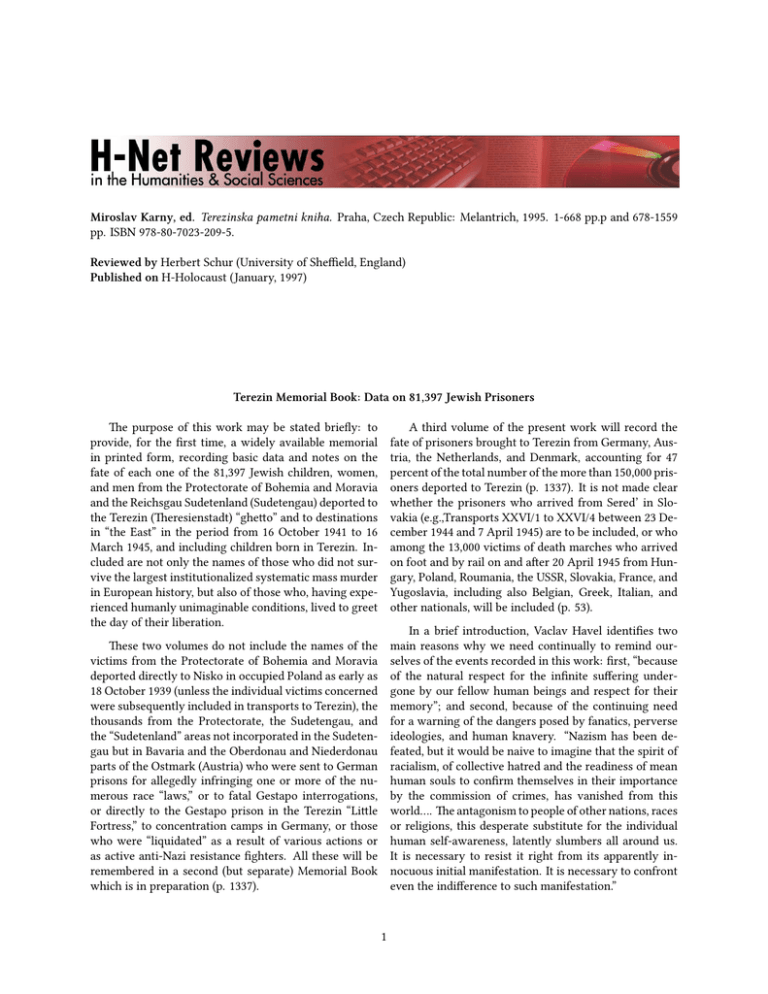
Miroslav Karny, ed. Terezinska pametni kniha. Praha, Czech Republic: Melantrich, 1995. 1-668 pp.p and 678-1559
pp. ISBN 978-80-7023-209-5.
Reviewed by Herbert Schur (University of Sheffield, England)
Published on H-Holocaust (January, 1997)
Terezin Memorial Book: Data on 81,397 Jewish Prisoners
A third volume of the present work will record the
fate of prisoners brought to Terezin from Germany, Austria, the Netherlands, and Denmark, accounting for 47
percent of the total number of the more than 150,000 prisoners deported to Terezin (p. 1337). It is not made clear
whether the prisoners who arrived from Sered’ in Slovakia (e.g.,Transports XXVI/1 to XXVI/4 between 23 December 1944 and 7 April 1945) are to be included, or who
among the 13,000 victims of death marches who arrived
on foot and by rail on and after 20 April 1945 from Hungary, Poland, Roumania, the USSR, Slovakia, France, and
Yugoslavia, including also Belgian, Greek, Italian, and
other nationals, will be included (p. 53).
The purpose of this work may be stated briefly: to
provide, for the first time, a widely available memorial
in printed form, recording basic data and notes on the
fate of each one of the 81,397 Jewish children, women,
and men from the Protectorate of Bohemia and Moravia
and the Reichsgau Sudetenland (Sudetengau) deported to
the Terezin (Theresienstadt) “ghetto” and to destinations
in “the East” in the period from 16 October 1941 to 16
March 1945, and including children born in Terezin. Included are not only the names of those who did not survive the largest institutionalized systematic mass murder
in European history, but also of those who, having experienced humanly unimaginable conditions, lived to greet
the day of their liberation.
In a brief introduction, Vaclav Havel identifies two
main reasons why we need continually to remind ourselves of the events recorded in this work: first, “because
of the natural respect for the infinite suffering undergone by our fellow human beings and respect for their
memory”; and second, because of the continuing need
for a warning of the dangers posed by fanatics, perverse
ideologies, and human knavery. “Nazism has been defeated, but it would be naive to imagine that the spirit of
racialism, of collective hatred and the readiness of mean
human souls to confirm themselves in their importance
by the commission of crimes, has vanished from this
world…. The antagonism to people of other nations, races
or religions, this desperate substitute for the individual
human self-awareness, latently slumbers all around us.
It is necessary to resist it right from its apparently innocuous initial manifestation. It is necessary to confront
even the indifference to such manifestation.”
These two volumes do not include the names of the
victims from the Protectorate of Bohemia and Moravia
deported directly to Nisko in occupied Poland as early as
18 October 1939 (unless the individual victims concerned
were subsequently included in transports to Terezin), the
thousands from the Protectorate, the Sudetengau, and
the “Sudetenland” areas not incorporated in the Sudetengau but in Bavaria and the Oberdonau and Niederdonau
parts of the Ostmark (Austria) who were sent to German
prisons for allegedly infringing one or more of the numerous race “laws,” or to fatal Gestapo interrogations,
or directly to the Gestapo prison in the Terezin “Little
Fortress,” to concentration camps in Germany, or those
who were “liquidated” as a result of various actions or
as active anti-Nazi resistance fighters. All these will be
remembered in a second (but separate) Memorial Book
which is in preparation (p. 1337).
1
H-Net Reviews
Virtually all the records from which the data on the
individuals listed have been extracted were in existence,
often in multiple copies and from multiple sources, in
Prague in May 1945. Some of these records, in the form of
lists and card indexes, were immediately made use of by
dedicated workers in the new Rada zidovskych nabozenskych obci v Cechach a na Morave [Council of Jewish
Religious Communities in Bohemia and Moravia] in providing an effective and efficient search service. The work
of correcting and filling in the gaps in the records appears to have continued until at least 1954-59, when the
names (with date of birth) of 77,297 Jewish victims from
Bohemia and Moravia murdered in Terezin and elsewhere were being inscribed on the walls in the Pinkas
synagogue, which had become the Holocaust memorial
in Prague. However, as a consequence of the political
change in February 1948, ideological (nominally “Socialist” or “Communist”) regulations and pressures ensured
that only minimal progress in the work of correcting
and filling gaps in the records and in exploiting these resources could take place, especially when requiring use
of complementary documentary resources and collaboration with research workers abroad. The freedom required for this work did not return until the major political changes following the November 1989 “velvet revolution,” notwithstanding some exchange of data in 1968-72
with the Juedisches Komitee fuer Theresienstadt in Vienna, Austria.
Karny) concerning access by, or for, foreigners to State
archives less than fifty years old, which states that “Permission to view will not be granted if, by viewing the
archives, state or societal interests could be endangered,
or [could endanger] the legitimately protected interests
of persons still living …” (Vladimir Bystricky and Vaclav
Hrub, Prehled archivu CSR [Praha: Archivni sprava ministerstva vnitra CSR, 1984], p. 23). The interests of the
state, the party, and Nazis and their collaborators at that
time still clearly rated higher than the dissemination of
information about the victims and of the claims of the
many still unsatisfied demands of timely justice.
With the change in the balance of power in the
leadership of the Communist Party of Czechoslovakia
in November 1989, photocopies of these lists were provided to Serge Klarsfeld overnight (p. 9). In 1990, the
Terezinska iniciativa [TI] adopted a proposal by Miroslav
Karny for publishing a Memorial Book, and when Klarsfeld learned of this initiative he and his colleagues presented the TI with all the data and computer programs
and the computerized database they already had available, to enable “the researchers in the country who are
cognizant of the problems and have available the most
accurate documentation” to complete the work (p. 10).
The chapter by Miroslav Karny, “The Genocide of
Czech Jews” (pp. 19-54), provides a historical background
briefing for the Czech user of the database. It touches on
the Nuremberg race “laws” and the concepts of “Glaubensjuden” and “Geltungsjuden,” of importance in the treatment of individuals and in statistics, notes the escape
of some 90 percent of the Jews from the “Sudetenland,”
following the Munich four-power accord, to the thenunoccupied parts of Czechoslovakia, and the legal and
“illegal” escape from the Protectorate of Bohemia and
Moravia after 15 March 1939.
Early in 1980 Serge Klarsfeld, who had published the
Memorial Book of the Jews of France (Le Memorial de
la Deportation des Juifs de France [Paris, 1978]), and had
participated in the production of the Memorial Books for
the Jews of Belgium (with Maxime Steinberg), Luxembourg (by Paul Cerf), and Italy (by Liliana Picciotto Fargion), among others, began to work on a Memorial Book
of Jews from Bohemia and Moravia, using resources at
Yad Vashem in Jerusalem, Israel; he was supported by
Ilan Kaufthal of New York (p. 9) and by Joseph and Betty
Saville of France, who created a computerized database
with information on “more than 70 000 Jews deported
from Bohemia and Moravia” (p. 10). The completion
of the work was effectively sabotaged by Czech bureaucrats who, in spite of the intervention of the Ministry
of Foreign Affairs of France, denied Klarsfeld access to
the records in Prague of those deported in eight transports sent directly to “the East” before Terezin became
the main concentration camp, euphemistically called a
“ghetto” or even “ghetto for old people,” for Jews from
Bohemia and Moravia. These bureaucrats presumably
relied on the regulation (not mentioned by Klarsfeld or
In the first of the seven sections under subheadings,
“The ghetto without walls” (pp. 23-27), examples of “legal” restrictions imposed on Jews by physical segregation
(similar to the isolation of persons with highly infectious
and contagious diseases), asset stripping and restriction
on incomes (both current and potential), “race”-restricted
food rations (i.e., slow starvation), and concentration in
localities from which mass deportations were planned to
take place, are noted.
In the second section, “The beginning of the stream
of deportations” (pp. 27-32), an account is given of the
discussions of various plans considered for carrying out
the Fuehrer’s wish to “liberate” the Reich and the Protectorate from the presence of Jews (p. 27), resulting in the
2
H-Net Reviews
selection of Terezin as the centre in which Jews would
be held for despatch to destinations in “the East.” Even
while these discussions were taking place, five 1,000strong transports were despatched from Prague to Lodz
and another one from Brno to Minsk, the first on 16 October 1941, the last exactly one month later.
lies (and collaborators) at El-Alamein (2 November 1942)
and Stalingrad (2 February 1943), a third objective gained
in importance–namely, the use of Jewish prisoners for
purposes of propaganda in an attempt to convince neutral observers and potential allies in an anti-Bolshevik
campaign of the humane and generous treatment of elderly Jews.
The third section, “Terezin as ghetto and concentration camp” (pp. 32-37), outlines the changes in Terezin, a
garrison town of 3,825 civilian inhabitants, 3,478 of Czech
and 347 of German “nationality” (at an unspecified date)
and a total population (including military) never exceeding 7,200, from the arrival of the Aufbaukommando of
342 Jewish prisoners on 24 November 1941 and that of
the first transport of 1,000 Jewish prisoners from Prague
just six days later, to the end of 1942. The first 1,000strong transport left Terezin for Riga on 9 January 1942
and was followed by another one six days later, followed
by transports to Izbica, Piaski, Rejowiec, Lublin, Warsaw,
Zamosc, Sobibor, Ujazdow, Trawniki, Maly Trostinec,
Baranovici, and Raasika, and 2,000-strong transports to
Treblinka, with the first transport to Auschwitz (Osvetim,
in Czech) comprising 1,866 prisoners on 26 October 1942.
The non-Jewish inhabitants of Terezin were required to
move out by 3 July 1942, and the (Czech) Protectorate
gendarmerie, who had been there to ensure the observance of the strict orders for the segregation of the Jewish prisoners from contact with the residents, and men
from women, was withdrawn by 12:30 on 6 July 1942.
This theme is developed in the fifth section, “The
Terezin Pseudoalibi” (pp. 41-48). This period saw the
first “beautifying” action, when, along the proposed distinguished visitors’ route, shops were built, one of the
squares got a park-like green area with a bandstand, another a children’s playground, a cafe and a concert hall
and theatre were constructed, and even streets were renamed from the unattractive L1-6 and Q1-9 to names like
Tower Street, Spa Street, Park Street, Lake Street, and so
on, to suggest a thriving spa town, populated by wellclad elderly Jews enjoying a happy retirement in the company of children. To create space and to eliminate the alltoo-obvious overcrowding, the population was reduced
by the tried expedient of despatching the “surplus” to
the death camps in “the East.” This carefully staged and
choreographed play was performed, after several postponements, on 23 June 1944 for two Danish officials and
Maurice Rossel, a Swiss member of the Berlin delegation
of the International Committee of the Red Cross (ICRC);
Dr. Rossel was impressed and sent photographs of his
visit to Eberhard von Thadden of the German Ministry for
Foreign Affairs, who used these in a foreign-press conference as evidence against “enemy propaganda on alleged
irregularities in the treatment of Jews resident in Europe”
(p. 47).
This period had seen the deportation to Terezin of
some three-quarters of the Jewish members of the population of the Protectorate of Bohemia and Moravia, as
well as the arrival of transports of elderly Jews from Austria and Germany so that, in spite of the massive deportations to “the East,” the number of Jewish prisoners in
Terezin increased to 58,491 by 18 September 1942. With
“living space” of 1.6 square metres (about 17.2 sq. ft.) per
prisoner (p. 34), some 6,000 of these “accommodated”
in damp eighteenth-century fortress casemates without
light, water, or toilets, and with bare floors, death from
“natural” causes reached 156 for that day.
All the children shown at play in these photographs
were sent to death in the gas chambers within four
months. Rossel’s report also described Terezin as an
“Endlager”–that is, a final destination camp, even though,
by July 1944, 68,000 had been despatched to death camps
in “the east,” and some 32,000 of the Jewish “residents,”
not having survived the actual conditions prevailing in
Terezin, had been cremated. This incorrect description
of Terezin placed in doubt the truthfulness of the AlThe narrative in this and the next, fourth, section on fred Wetzler-Walter Rosenberg (Rudolf Vrba) report of
“Metamorphoses of Terezin” (pp. 37-41) suggests that, far April 1944 (Rudolf Vrba and Alan Bestic, I Cannot Forgive
from an efficient selection of prisoners in support of the [London, 1963]) noting the deportations from Terezin to
Nazi ideological aims on one hand and of the manpower
Auschwitz, and may well have had the effect of persuadneeds of the war effort in support of the Wehrmacht on
ing the ICRC not to proceed with the planned visit to
the other, the actual selection (for instant death or for the “Arbeitslager Birkenau bei Neu-Berun”–that is, to the
death after a period as slave labourer) was the result of “family camp” for some Czech Jews from Terezin in a
ad hoc decisions at various levels of the SS hierarchy. Fol- section of the Auschwitz concentration camp complex,
lowing the decisive defeats of the Wehrmacht and its al- prepared for such a visit. This “family camp,” kept ready
3
H-Net Reviews
for some six months, was liquidated in July 1944, when
it became clear that it was not going to be required. Almost 6,500 surviving prisoners there, including hundreds
of children, were sent to the gas chambers, and 3,500
prisoners, considered to be fit for dangerous work in the
war effort, were sent to various plants, including some
built underground, mines, and quarries, and concentration camps in Germany, with a few dozen of the survivors
finding themselves back in Terezin by late April and May
1945. On 6 April 1945 another performance was staged
for a delegation from the ICRC, the report by Otto Lehner
being “even more unconscionable than that of Maurice
Rossel” (p. 52).
priority, at least for some, the retention of small numbers of hostages to be used as a shield in a last stand in
Bohemia and Austria while attempting to persuade the
western Allies to join Germany in forming a victorious
common front against the “Bolsheviks.”
The seventh section describes “The final metamorphosis of the Terezin camp” (pp. 50-54). The last transport from Terezin left on Czechoslovak Independence
Day, 28 October 1944, and action was taken to destroy
any remaining evidence of the high “natural” mortality
of prisoners in Terezin by throwing the ashes of some
17,000 cremated prisoners into the river Ohre and the remainder into a pit near the Litomerice (Leitmeritz) concentration camp in the Sudetengau nearby (p. 52). Karny
outlines various attempts, both by Jewish and other (US,
Swedish, Swiss, etc.) negotiators to exploit the increasing realization among some of the leading Nazi criminals
that the Thousand-Year Reich was coming to an end to
save at least some of the the Jewish victims from certain death. Although a few thousand concentration camp
prisoners, including 1,368 from Bergen-Belsen on 6 December 1944 and about 1,200 from Terezin on 5 February
1945, were allowed to reach and to enter Switzerland, the
overriding priority for the Nazis still remained the perfect
crime with no survivors, no witnesses able and willing
to testify, and no evidence, such as gas chambers, crematoria, unburied or even buried bodies, and, as second
The major contribution of the team working on the
database lies in the care taken to identify each individual
by an exhaustive (and exhausting) comparison of records
in various sources, and, in some cases, by supplementing these by checking with survivors, including Alisah
Schillerova, who heads the computerized database of Beit
Theresienstadt, Givat Chaim Ichud, Israel. Although not
all the information available has been published in this
printed database, the description of the primary sources
used (pp. 55-61 and Appendix C of this review) should
enable those wishing to find additional information, such
as place of birth, names of parents, last known address,
etc., to go to the most promising sources–which, it may
now be expected, will be opened to all, regardless of citizenship, “nationality,” or other restrictive characteristic,
and without bureaucratic obstacles and procrastination.
Terezin became, from 20 April 1945, a destination for
death marches and for transports evacuating concentration camps and forced labour camps ahead of the Allied armies, with the survivors, exhausted, starved, and,
suffering from typhoid, typhus, and other infectious diseases, ultimately increasing its population to over 30,000.
An epidemic spread rapidly, and of the more than 2,000
victims affected, some 500 died. Terezin was handed over
In the sixth, brief, section “Autumn [Fall 1944] liq- to Paul Dunant of the ICRC on 5 May 1945, SS Lagerkomuidation transports” (pp. 48-50), the major push given mandant Karl Rahm leaving, by SS chauffeur-driven car,
to the programme for murdering as many Jews as pos- on the same day. On 8 May, shooting by retreating
sible, in the rapidly shrinking period before the ever SS units still caused two deaths in Terezin, but by the
more probable end of the Thousand-Year Reich, led to evening, the first units of the Red Army advancing on
eleven transports with 18,402 prisoners being despatched Prague from the north were welcomed there.
within one month from 28 September 1944 from Terezin
This introduction is followed by the raison d’etre of
to Auschwitz, with just 1,474 of these prisoners surviving
this
work, the database. This, it is hoped, can be used
there and, following evacuation, to other death camps,
effectively
by readers not fluent in Czech, by using insome incorporating branch plants of well-known and
formation
provided
in the appendices to this review–
profitable German industrial undertakings, and death
Appendix
A:
Contents,
Appendix B: Guide to database
marches. Before these transports were despatched, a film
entries and to use of the Index of Names, and Appendix
unit produced a “documentary film” on the sweet life in
C: Catalogues and other sources used.
Terezin. In the event, the Nazi propagandists did not
make use of this film.
Comments
The most disappointing part of this work is, unexpectedly, the paper on the “Genocide of Czech Jews” (pp.
19-54) by Miroslav Karny. The Czech reader will find not
a single full reference to a publication in Czech relating
to and amplifying the details of the events leading to the
4
H-Net Reviews
genocide, nor, for that matter, will the reader find references to publications in any other language, whether
published in Czechoslovakia (such as Karny’s own papers
in Judaica Bohemiae and elsewhere) or abroad. There
is not even a short bibliography for “further reading” to
help the interested reader.
which Jews were specifically singled out as posing the ultimate threat to the continued existence of human life on
earth, that led to the “Final Solution.” Mussolini despised
the Nazi racialism in 1933 and 1934 (see Meir Michaelis,
Mussolini and the Jews: German-Italian Relations and the
Jewish Question in Italy, 1922-1945 [Oxford: The Clarendon Press, 1978], pp. 74-77).
The reader, even one having a command of Czech,
will find that places are mentioned, both in Bohemia
Though the enthusiastic voluntary collaboration by
and Moravia and in other parts of Europe under Ger- some opportunists (individuals, governments, and pubman occupation, but no glossary is provided of place lic, professional, and trade institutions and associations)
names in Czech and their equivalents in other languages, with the Nazis, even before the total occupation of Bosuch as Litzmannstadt (a name not recorded in the pre- hemia and Moravia, must not be forgotten, the help given
Nazi edition of the Meyers Lexikon, vol.7 [Leipzig: Bib- by decent individuals at the risk of their, and the prisliographisches Institut, 1927], but, possibly, named af- oners’, lives needs to be praised and remembered. One
ter the Prussian General Karl Litzmann) for Lodz, Os- would therefore have expected more to have been said
vetim/Oswiecim/Auschwitz, Drazdany/Dresden, Lip- about, for instance, the help given to the Terezin prissko/Leipzig, Vratislav/Wroclaw/Breslau, Kralovec/Koenigsberg/[now
oners as soon as the SS flag there was taken down, by
Kaliningrad], and so on. No maps are provided to show the medical personnel, administrators of hospitals and
where these places are (perhaps also showing the road, sanatoria, the ambulance and the Red Cross services
rail, and river communications). The identification of and pharmacies in Prague, less than 40 miles distant,
places such as labour camps and temporary concentra- particularly before the Red Army placed its own medtion camps (e.g., in Most), and places such as mines and ical services and army hospitals in the service of savagricultural and industrial plants employing slave labour, ing life in Terezin. It is significant that, according to
in Bohemia and Moravia and elsewhere, would have been Eva Schmidt-Hartmann, some 700 “Protektoratsangehoparticularly useful.
erige” prisoners managed to leave the Terezin “ghetto”
in the days before its liberation (Eva Schmidt-Hartmann,
In view of President Havel’s warning, the point
“Tschechoslowakei,” in Wolfgang Benz, et al., Dimension
should have been made that many of the features of the des Voelkermords [Muenchen: R. Oldenbourg, 1991], p.
“solution of the Jewish problem” as implemented by the 368).
Nazis, their allies, and collaborators were not unknown
in European “culture,” legal codes, and practice, includSince this work was published in 1995, one would
ing in Bohemia and Moravia. It was the wishful thinking expect that it would have taken into account earlier
that “it can’t happen in civilized countries in this modern publications. While Karny dates the arrival of the Red
age” that led to ignoring even the possibility that many Army in Terezin as 8 May 1945, Lederer (Zdenek Lederer,
of these features might be, or might become, acceptable “Terezin,” in Avigdor Dagan, et al., The Jews of Czechosloeven to professors in top universities, a few Nobel Prize vakia, vol. 3 [Philadelphia, Pa.: The Jewish Publication
laureates, as well as to some members of the “nobility,” Society of America, 1984], p.145), dated this 11 May 1945,
captains of industry, and church dignitaries and might and Edelheit (Abraham J. Edelheit and Herschel Edelefficiently be implemented by the government and bu- heit, History of the Holocaust:.. [Boulder, Colo.: Westview
reaucrats of just such a “civilized” European country (see, Press, 1994], p. 334), implausibly, as 2 May 1945. Simie.g., Raul Hilberg, The Destruction of European Jews [New larly, there is doubt about the exact date from which the
York and London: Holmes and Meier, 1985], or earlier ICRC was in charge of Terezin. Karny states this (p. 54)
editions: Chapter 1. “Precedents,” pp.5-28, esp. Tables as 5 May 1945, Lederer (op. cit., p.145) as 2 May 1945,
1-1 and 1-2, and Chapter 10. “Reflections: The Perpetra- when the SS flag was hauled down and replaced by the
tors,” pp. 993-1029).
flag of the ICRC.
For the Czech reader, taught to lump all opponents of
“socialism” under the blanket label of “fascists,” there is
the need to point out that the one feature which distinguished the Nazi movement from all other “fascists” was
that of “race.” It was the Nazi concept of “race,” within
In view of Karny’s comment on Otto Lehner’s report
on Terezin (p. 52), it would have been useful to know
whether or not Paul Dunant of the ICRC and SS Obersturmbannfuehrer Adolf Karl Eichmann were present at
this ICRC visit on 6 April 1945, a three-man ICRC delega-
5
H-Net Reviews
tion visit “accompanied by Adolf Eichmann and other SS general survey, all including numerous bibliographical
officers” on that date being noted by Lederer (op. cit., p. references to sources.]
143), and whether Paul Dunant met Benjamin MurmelBystricky, Vladimir, and Vaclav Hruby. Prehled
stein on this occasion, as also noted by Lederer (op. cit.,
archivu
CSR (Praha: Archivni sprava ministerstva vnitra
p. 143).
CSR, 1984), 209 pp; p.23. [N.B. CSR = Ceska socialisticka
The lack of any bibliographical references also makes republika] [Guide to archives in the CSR]
it impossible to discover why the author states (p. 52) that
Collis, W. R. F. “Belsen Camp: A Preliminary Report,”
it was at Bergen-Belsen that “American soldiers stood
British Medical Journal, 9 June 1945, pp. 814-16. [First,
in horror at the sight of heaps of bodies” and not, perhaps, at Ohrdruf (“Belsen Concentration Camp,” Lancet, brief, report by the Senior Medical Officer “after 24 hours’
12 May 1945, pp. 604-5; W.R.F. Collis, “Belsen Camp: A contact with the camp.” Includes sketch plan of camp.]
Preliminary Report,” British Medical Journal, 9 June 1945,
Dagan, Avigdor, editor-in-chief.
The Jews of
pp.814-16; Abraham J. Edelheit and Herschel Edelheit, op. Czechoslovakia: Historical Studies and Surveys. Vol. 3
cit, p.147). And one could multiply such examples of ex- (Philadelphia, Pa.: The Jewish Publication Society of
cathedra assertions.
America and Society for the History of Czechoslovak
Jews, 1984). ISBN 0-8276-0230-8; xli + 700 pp. [See parThe database, on the other hand, has, when tested,
proved reliable. When tested against a list of just twenty ticularly Kulka, Lederer, Lexa, and Rothkirchen, as well
names that had been checked in Prague in May 1946, of as other studies in this volume.]
which two were then reported as “no record found,” all
were found in this work; of thirty dates of birth checked,
only one was partly incorrect, though the correct year
(1933) could have been deduced from a note of age in
three of Eva Schurova’s drawings dating from 1943 and
1944 in the Prague Jewish Museum collection (e.g., Drawing 133.258/3.325/), and confirmed from a source in the
Yad Vashem library.
Edelheit, Abraham J., and Herschel Edelheit. History of the Holocaust: A Handbook and Dictionary (Boulder, Colo., San Francisco, Calif. , and Oxford: Westview Press, 1994). ISBN 0-8133-1411-9; ISBN 0-81332240-5(pbk.) 524p. p.147 [includes picture], 334.
Hilberg, Raul. The Destruction of European Jews
(Chicago, Ill.: Quadrangle Books, 1961). 788 pp.; (New
York: Octagon Books, 1978), ISBN 0-347-93888-1. viii +
790 pp.; (New York and London: Holmes and Meier, 1985,
rev. and definitive ed.), ISBN 0-8419-0832-X (set). xii +
1274 pp. (in 3 vols.). [Concerned primarily with the policy and the organizational, and management aspects of
this “enterprise.” Note on, mainly primary, sources for
further study, pp.1223-31.]
Finally, the editors’ appeal (p. 1339), for all corrections, addenda, and comments, to be sent to them at the
Nadace Terezinska iniciativa, Maiselova 18, 110 00 Praha
1, Czech Republic, should be noted, so that they can be
taken into account in the continuing project and publications.
References
Klarsfeld, Serge. Le Memorial de la Deportation de
Juifs de France (Paris: B. et S. Klarsfeld, 1978). (not paginated, no ISBN).
Anon. “Belsen Concentration Camp: The Medical
Services Take Over,” Lancet, 12 May 1945, pp. 604-5.
[First report in a medical journal reporting on period
from 12 to 17 April 1945.]
Kulka, Erich. “The Annihilation of Czechoslovak
Jewry,” in Dagan, Jews of Czechoslovakia, pp. 262-328.
Benz, Wolfgang, et al. Dimension des Voelkermords: Die Zahl der juedischen Opfer des Nationalsozialismus. Quellen und Darstellungen zur Zeitgeschichte Herausgegeben vom Institut fuer Zeitgeschichte, Band 33.
(Muenchen: R. Oldenbourg, 1991), ISBN 3-486-54631-7,
584 pp. [For Czechoslovakia see Eva Schmidt-Hartmann.
Other countries include the German Reich, Austria, Luxembourg, France and Belgium, the Netherlands, Denmark, Norway, Italy, Albania, Greece, Bulgaria, Yugoslavia, Hungary, Roumania, Poland, the USSR, and a
Lederer, Zdenek. “Terezin,” in Dagan, Jews of
Czechoslovakia, pp. 104-64. [Includes a particularly relevant annotated bibliography, pp.152-64.]
Lexa, John G. “Anti-Jewish Laws and Regulations in
the Protectorate of Bohemia and Moravia,” in Dagan,
Jews of Czechoslovakia, pp. 75-103.
Marrus, Michael R.,ed. The Nazi Holocaust: Historical Articles on the Destruction of European Jews, vol. 9:
The End of the Holocaust (London and Westport, Conn.:
6
H-Net Reviews
Meckler, 1989), ISBN 0-88736-256-6. [Collection of selected reprints. See particularly Rothkirchen, cited below.]
and from Terezin (16.10.1941-15.4.1945) [list of transports] [date of departure/code of transport/departure
from/number of persons /destination].. 63
Michaelis, Meir. Mussolini and the Jews: GermanItalian Relations and the Jewish Question in Italy, 19221945 (Oxford: The Clarendon Press for the Institute of
Jewish Affairs, London, 1978), ISBN 0-19-822542-3. xiii +
472 pp., pp. 74-77.
7. Equivalents of given names: Part I: Czech-other
[usually German], Part II: other-Czech [see 24. below]
…… 75
8. Transports A to E from Prague to Lodz (16.10.19413.11.1941) [annotated lists of prisoners] …………………. 77
Rothkirchen, Livia. “The Jews of Bohemia and
9. Transport F from Brno to Minsk (16.11.1941) [anMoravia, 1938-1945,” in Dagan, Jews of Czechoslovakia,
notated
list of prisoners]…………………………………. 139
pp. 3-74.
10. Transports to Terezin from the Protectorate
Rothkirchen, Livia. “The ’Final Solution’ in its Last
Bohemia
and Moravia (24.11.1941-26.6.1942) [annotated
Stages,” in Marrus, Nazi Holocaust, pp. 342-55.
lists of prisoners] .. 151
Schmidt-Hartmann, Eva. “Tschechoslowakei,” in
11. Transports from Prague to Ujazdow (10.6.1942)
Benz, Dimension des Voelkermords, pp. 353-79.
[annotated lists of prisoners]……………………………….. 666
Vrba, Rudolf, and Alan Bestic. I Cannot Forgive (LonVolume 2
don: Sidgwick & Jackson; Anthony Gibb & Phillips,
1963), 278 pp.
12.
Transports to Terezin from the Protectorate Bohemia and Moravia (2.7.1942-26.1.1945)
Appendices
……………………….. 689
[In order to make this book, written in Czech, more
13. Transports St-Ez to Terezin from Prague of
useful to non-Czech-readers, the reviewer has prepared
individual
prisoners [Sondertransporte-Einzelreisende]
several appendices to his review: a detailed list of the ta(7.2.1942-13.11.1944)
[annotated list of prisoners] …….
ble of contents, guides to the notation used in the entries
1264
and to the index of names, and a list of the sources used
by the editors of the book under review.]
14. Transports AE to Terezin from the Protectorate
Bohemia
and Moravia and the Sudetengau [“ArbeitseinAppendix A: List of Contents
satztransporte” of Jewish “mixed-marriage” and “mixedThe following Contents List in English, prepared by descent” prisoners] (31.1.1945-16.3.1945) [annotated list
the reviewer, is an expanded version of the text in Czech of prisoners] ……. 1272
in the original publication.
15. Transports to Terezin from the Sudetengau
Volume 1
(13.11.1942-7.3.1945) [annotated list of prisoners] …….
1317
1. A word from Vaclav Havel [President of the Czech
Republic].. 7
16. Children born in Terezin (13.2.1942-5.3.1945) [annotated list of prisoners]……………………………… 1332
2. Serge Klarsfeld: toward the Terezinska pametni
kniha …. 9
17. Documentation appendix [a note] ………………..
1337
3. Guide to the Terezinska pametni knih …………..13
18. Table 1: List of deportation transports from Bo4. Miroslav Karny: The genocide of Czech Jews hemia and Moravia [Protectorate and Sudetengau] to
………… 19
Terezin and the fate of the prisoners [code of trans5. Sources used [see also Appendix C of this review] port/place of departure/ date of departure/number of
prisoners/died/liberated/fate undetermined, and notes]
….. 55
………………. 1341
6. Chronological survey of Jewish deportation trans19.
Table 2: Fate of prisoners deported [diports from Prague to Lodz and Ujazdow, and from Brno
to Minsk, and of all deportation transports to Terezin rectly] from Prague and Brno to Lodz, Minsk, Ujaz7
H-Net Reviews
dow, and Auschwitz (16.10.1941- 27.10.1944) [code of
transport/place of departure/ destination/date of departure/number of prisoners/died/liberated]……… 1344
ume (pp.13-17, 1349 et seq.):
The entries are arranged in the following form:
Heading for transport
20. Bar chart of Table1 [x=date of departure,
y=number of prisoners; black=died, white=liberated]
1. Transport Z - Kladno Transport code - place of de………… 1345
parture
21. Bar chart: Fate of prisoners deported to Terezin
from Bohemia and Moravia (24.11.1941-16.3.1945)
[not deported from Terezin/deported from Terezin.
y=number of persons; black=died, white=liberated; the
first column includes among those liberated those transported on 5..2.1945 to among those liberated those transported on 5.2.1945 to Switzerland. Of the 7,240 prisoners liberated in Terezin only 3,376 had been transported
there before 28.10.1944 when the last transport departed
for the extermination camps in occupied Poland. The
majority of those liberated were prisoners from transports AE (see 14, above). The 110 prisoners whose fate
could not be determined are not included in this chart.]
….. 1346
2. Terezin 26. unora 1942 Destination - date of departure for destination [N.B.: the genitive forms of the
months of the year are: ledna, unora, brezna, dubna,
kvetna, cervna, cervence, srpna, zari, rijna, listopadu,
prosince.]
3. 756 zahynulych : (number of prisoners) died
4. 66 osvobozenych: (number of prisoners) liberated
5. 1 osud nezjisten: (number of prisoners) fate undetermined
Section subheading
Zahynuli: died
22. Bar charts: Fate of prisoners aged to 15, deported to Terezin from Bohemia and Moravia (24.11.194116.3.1945) [as previous chart; age at date of deportation]
Fate of children born in Terezin to parents deported from
Bohemia and Moravia [no child deported from Terezin
survived to liberation] ………… 1347
Osvobozeni se dozili: survived to be liberated
Dalsi osud nezjisten: further fate not determined
Individual entry:
1.
Schindlerova ( ) Vera:
spelling)/Given name
23. Bar chart: Age structure of prisoners deported to
Terezin from Bohemia and Moravia. Age at date of deportation …. 1348
Surname/(variant
2. [ ]: [postwar married or changed name]
3. *22.7.1931: date of birth (day, month, year)
24. Index of names [See also 7, above]. Since given
4. Es-19.10.1944: Transport code - date of departure
names were not consistently recorded in Czech or Ger- from Terezin (day, month, year).[N.B. GSt = moved to the
man or as normally used by the prisoner himself or her- Gestapo prison in the Little Fortress in Terezin]
self, Jan might be recorded as Hans, and, later, Siegfried
or Viktor as Vitezslav. The “race-identifier” names of Is5. Outcomes:
rael and Sara were omitted when added by the authorities
v: died in (place) on (date) [N.B.: The v is a
for that purpose. Surnames in parentheses are variant
downward-pointing solid triangle.]
versions found in the card-index sources; those in square
brackets are the [most recent] surname following marosv.: liberated
riage or name change following liberation. See also Ap[N.B.: The place of liberation is either the actual place
pendix B of this review]…. 1349
or the last concentration camp imprisoned in. This part
Plates: 16 pages of b/w plates are inserted in each one completed only if information relating to the specified
of the two volumes, following p. 144 in Vol. 1 and p. 1336 individual has been recorded -otherwise fate unknown,
in Vol. 2.
presumed dead (on the basis of totals recorded for give
transport).]
Appendix B
Index of names [p.1349 et seq.]
The following notes have been prepared by the reviewer on the basis of information provided in the vol1. The alphabetic sequence is that of the Czech alpha8
H-Net Reviews
bet, i.e., ch follows h, and consonants C, R, S, and Z with
a hacek (v) follow those without.
fare] and material lent by the narodni sprava [national
custodian] of the Ustredna pro zidovske vystehovatelstvi
[Central Office for Jewish Emigration], later renamed Ustredni urad pro usporadani zidovske otazky [Central Office for the Solution of the Jewish Problem]. This card
index is currently being held in the archive of the Federace zidovskych obci v Ceske republice [Federation of
Jewish Communities in the Czech republic].
2. Note that in Czech the feminine form of the surname has the suffix -ova (with an acute accent on the a),
e.g. Schindler (m), Schindlerova (f); when the masculine
form ends in a short vowel(i.e., one without an acute accent), this vowel is dropped before adding the suffix, thus
Fanta (m), Fantova (f), except in names ending in i or y
of foreign origin, such as Levi (m), Leviova (f). However,
when the name can be considered as derived from an adjective in Czech, or is of an adjectival form, such as Levy
(with an acute accent on the y) (m), appearing to be derived from the Czech for “left,” the feminine is formed as
if it were an adjective, hence Leva (with an acute accent
on the a) (f). Names ending in -ek or -ec in the masculine
form usually drop the e in the feminine form, such as Jelinek (m), Jelinkova (f), Moravec (m), Moravcova (f), but
practice is not consistent and the feminine form of Hayek
(m) appears as both Haykova (f) and Hayekova (f), and of
Hatschek (m), as Hatschkova (f) and Hatschekova (f). The
adjectival form also influenced a small number of names
derived from nouns. so that Krejci (with a hacek on the
c) (m), from the Czech for “tailor,” remains unchanged as
Krejci (with a hacek on the c) (f) in the feminine form.
2. The second source was the book Terezin-ghetto,
published by the Ministerstvo ochrany prace a socialni
pece [Ministry of the protection of labour and social welfare] in 1945. This includes the names and basic personal
details of all prisoners deported to Terezin and liberated
in Terezin, arranged in two sections: the first, of those
deported before 20 April 1945, the second of the fewer
than 14,000 survivors of death marches from concentration camps “evacuated” just ahead of the liberators.
3. The result of the work between 1968 and 1972 of
the Jewish Committee for Terezin [Juedisches Komitee
fuer Theresienstadt] in Vienna (Austria) was made available in the form of a microfilm listing nearly 120,000 prisoners of the Terezin “ghetto.” This database made use,
inter alia, of the records in the Prague central card index (noted in 1, above), and microfilms of records held by
For an outline of the grammatical rules and excep- the International Search Service [Internationaler Suchditions to them in actual practice see, for instance, Bo- enst] in Arolsen (Germany). Copies of this listing were
huslav Havranek and Alois Jedlicka, Ceska mluvnice presented to the Pamatnik Terezin [Memorial “Terezin”]
(Praha: SPN, 1963), pp. 118, 157-58.
in Prague, the International Search Service in Arolsen,
Yad Vashem in Jerusalem, and other institutions. The
Appendix C
names are grouped by countries from which the deportaThe following note on existing sources used (directly tions took place, including Austria, Czechoslovakia, Geror indirectly) in the present project was prepared by the many, and the Netherlands (all in the pre-1938 borders),
reviewer on the basis of information provided in the pub- and other “Foreign” according to citizenship of the prisoner. It was expected that the various countries of orilication (pp. 55-61) in Czech only.
gin of the victims would carry out further work on the
1. The basic source is the card index prepared in the listings, and the first printed database, for Austria, was
immediate postwar period by the Records Office [evi- published as Totenbuch Theresienstadt (Wien: Juedisches
dencni oddeleni] of the Rada zidovskych nabozenskych Komitee fuer Theresienstadt, 1971) and an enlarged and
obci v Cechach a na Morave [Council of Jewish Reli- corrected edition, Totenbuch Oesterreich - Deportierte aus
gious Communities in Bohemia and Moravia], compris- Oesterreich (Wien: [Mary Steinhauser and] Dokumentaing a central card index together with a series of sup- tionsarchiv des oesterreichischen Widerstandes [DOW],
plementary indexes built up on the basis of the then- 1987). The entries include given name, surname, date of
available sources, such as lists and written material of birth, prisoner’s number for the transport to Terezin, and
the Rada starsich v Praze [Council of Elders in Prague], date of death in Terezin, rarely recorded when following
the successor of the Prazska zidovska nabozenska obec a further deportation.
[Prague Jewish Religious Community] closed down in
4. By 1991 both the political environment and the
1943. The central card index made use of lists of [deportation] transports then held by the repatriation sec- technological facilities available for work in this area
tion of the Ministerstvo ochrany prace a socialni pece had changed radically, and work was started by the
[Ministry of the protection of labour and of social wel- Terezinska iniciativa with the help of the Ustav teorie
9
H-Net Reviews
informace a automatizace Akademii ved v Praze (UTIA)
[Institute for the Theory of Information and Automation of the Academy of Sciences] on the first machinereadable database of the names and personal details
of some 150,000 victims deported to Terezin. On 25
November 1993 a report on the first stage of the project
“Stopadesat tisic jmen–stopadesat tisic lidskych osudu”
[150,000 names–150,000 human fates (sic–a more appropriate term might be tragedies)] together with the
database on a set of diskettes was presented to President
Vaclav Havel. This database made use of the data in 2
and 3, above, together with data on some 3,400 prisoners
who survived a further deportation from Terezin, gathered from various sources.
The registration number (f) is the personal identity
number assigned to each individual person falling within
the scope of the Nuremberg “laws.”
2) Transport lists from Terezin to further concentration camps:
As 1), above, except that e) includes the code and
number of the transport to Terezin. These lists represent
the actual “despatch lists” for each transport.
3) Deportation card index of persons sent to Terezin
from the Protectorate of Bohemia and Moravia:
a) name and surname, and, in some cases, the academic title
5. In the second stage of the project (see 4, above)
the database was enlarged by the addition of data for
the transports from Prague to Lodz and Ujazdow, from
Brno to Minsk, from Moravska Ostrava to Nisko, and
by data on the Jewish prisoners in the “Little Fortress”
in Terezin. This second stage provided the data for
the present publication following an exhaustive checking and cross-checking of data obtained from sources
held in the archive of the III. oddeleni Statniho ustredniho archivu Koncentracni State Central Archive Concentration Camps - Occupation Prison tabory - okupacni
vezenske spisy (KT-OVS) [Third Section of the Records].
This archive comprises two parts. The first part comprises documents from prisons and courts in the Protectorate of Bohemia and Moravia and fragmentary documentation of this type from Berlin and Breslau, all for
the period 1939 to 1945. The second part comprises
documents from concentration camps, penitentiaries and
prison transports, card indexes and registers, including:
b) profession
c) registration number
d) last address before deportation
e) date of birth
f) particulars of return
g) date and code of transport to Terezin
h) date, code, and destination of transport from
Terezin
ch) particulars of death in Terezin or other concentration camp.
The card index comprises some 74,000 cards, which
appear to have been prepared on the basis of transportation lists and updated with information on return by the
repatriation section of the Ministerstvo ochrany prace a
socialni pece [Ministry of the protection of labour and
1) Transport lists to the Terezin “ghetto” from the Pro- social welfare].
tectorate of Bohemia and Moravia:
4) The original card index of the Terezin “ghetto”: In
a) sequential number of the person in the transport
most cases two cards were completed for each person:
b) surname and name, and, in some cases, the aca- one for identification purposes, the other for “residential”
ones. It is highly probable that this card index includes
demic title
only persons liberated from the Terezin “ghetto,” includc) profession
ing those arriving after 20 April 1945 with the death
marches. Information recorded is similar to that recorded
d) date of birth
in 3), with the addition of religion. The “residence” card
e) last address before deportation
includes information of the address of the prisoner in
Terezin and of the departure from or date of death in
f) registration number of the person
Terezin after liberation.
g) code and number of transport from Terezin
5) Card index of survivors of those transported to “the
east”:
h) date of death in Terezin
a) name and surname
10
H-Net Reviews
b) date of birth
ber, and date of cremation.
c) region from which the person had been transported
to Terezin
The KT-OVS archives (see 5, above) also include a
card index of deportations to Terezin and incomplete
transport lists from regions outside the Protectorate.
d) date and code of transport to Terezin
The Archives of the Pamatnik Terezin [Terezin
Memorial] received in 1986 from the Rada zidovskych
nabozenskych obci v Praze [Council of Jewish Religious
Communities in Prague] contains registration lists of
f) particulars of return and address
Jewish inhabitants in the Protectorate of Bohemia and
A list of survivors, based on this card-index, also ex- Moravia, and transport lists of all transports from the
ists.
Protectorate to Terezin. The transportation lists were an6) Card index of prisoners who died in the Terezin notated, immediately after the War in the Rada, with information about date of death in Terezin, whether trans“ghetto”:
ported from Terezin, which transport and transport numa) name and surname
ber, and whether survived. Noted here is also information about the handing over of the prisoner to the
b) place and date of birth
Gestapo, escapes, and, in a few cases, “de-ghettoization.”
The records also include information about children born
c) names of parents (not invariably included)
in Terezin and their fate.
d) nationality
The files of direct deportation transports from Prague
e) address before deportation
and Brno to Lodz, Minsk, amd Ujazdow are held in the
Zidovske muzeum v Praze [Jewish Museum in Prague],
f) date and place of death
formerly the Statni Zidovske muzeum v Praze [State Jewg) note (usually designation of transport to Terezin) ish Museum in Prague].
e) date and code of transport from Terezin to “the
east”
This card index includes cards for all prisoners dying
in Terezin, i.e., including also those from regions outside
the Protectorate of Bohemia and Moravia. The card index, compiled after the war, is based on contemporary
documents from Terezin and accounts of witnesses.
Some of the remaining problems of identification
were cleared up with the help of an analogous project
at Beit Theresienstadt, Givat Chaim Ichud, Israel (Alisah
Schillerova, Head) and materials from the estate of G.
Weiss in the archives of Yad Vashem, Jerusalem, Israel.
7) Card index of prisoners cremated in the Terezin
Copyright (c) 1997 by H-Net, all rights reserved. This
“ghetto”:
work may be copied for non-profit educational use if
Includes only name and surname, registration num- proper credit is given to the author and the list. For other
permission, please contact H-Net@h-net.msu.edu.
If there is additional discussion of this review, you may access it through the network, at:
https://networks.h-net.org/h-holocaust
Citation: Herbert Schur. Review of Karny, Miroslav, ed., Terezinska pametni kniha. H-Holocaust, H-Net Reviews.
January, 1997.
URL: http://www.h-net.org/reviews/showrev.php?id=759
Copyright © 1997 by H-Net, all rights reserved. H-Net permits the redistribution and reprinting of this work for
nonprofit, educational purposes, with full and accurate attribution to the author, web location, date of publication,
originating list, and H-Net: Humanities & Social Sciences Online. For any other proposed use, contact the Reviews
editorial staff at hbooks@mail.h-net.msu.edu.
11

